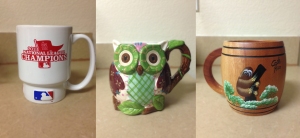So my primary interest in the design world is print design. This is no secret. I enjoy seeing beautiful front pages, dynamic doubletrucks and just overall clean design.
On a separate note, I also really like sports. So being in Missouri at a time like this, with both baseball teams in the playoffs, is really great. I can watch the drama of the sports world unfold on the front pages of the state newspapers. I am from St. Louis, so I am naturally a St. Louis Cardinals fan. I usually look to the St. Louis Post Dispatch.
On the front of today’s Post Dispatch, they moved the flag down the page a bit and placed a photo of last nights Cardinal loss at the top, captioned “On the Brink.” Inset, they have a smaller photo showing a celebration shot from the Kansas City Royals because they are now ALCS champs and headed to the World Series.
I think the design is really clever, but maybe not executed extremely well. I like that there is good contrast in multiple aspects of the photo combination. There is a contrast of emotion, between the Royals celebration and the Cardinals’ gloom. I like the idea of an inset image, but I think in this case with the picture and the headline on the top of the photo and surrounding the action, it becomes too messy.
From the other side of the state, The Kansas City Star featured one dominant (almost poster-sized) image, with the headline “World Class.” This design is really simple but pulls off the message very well. They let the image speak for itself.
The Post Dispatch had an additional design dedicated to the Cardinals on the sports front, with the punny headline “Blunder-ful.” With a one word headline, and not using a deck or inset picture in addition to the dominant image, I think the sports front page did a better job in conveying the feeling of disappoint following the Cardinals’ loss.
Our own Columbia Missourian featured a sports front dedicated to the Royals. I really liked this page because it was simple and featured the two small yet moving words: “At Last.” The photo also took up all the above-the-fold space, from one side of the page to the other, leaving no blank margin space. I think this gave the page a classy feel and emphasized even more meaning of the win.
Out of all three designs, I like the Missourian’s sports front the best. I think the short headline with the dominating photo showing the emotion of the moment is the best way it could have been done. The Star’s page was good and showed a great group celebration shot, but the photo the Missourian staff chose seems to easily sum up the fan base’s feelings in one person. As for the Post Dispatch, if the Cardinals had pulled off a winner last night then there would have been better design opportunity there. It would have been inappropriate at the Post-Dispatch to feature a dominant photo the size of the Star’s photo featuring the disappointing loss, especially since the Cardinals aren’t out of the series yet.
Sometimes it is necessary to have complicated design to communicate a difficult message. However, in most of these instances, the sports photos can speak for themselves with minimal design effort.



